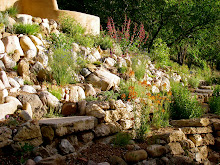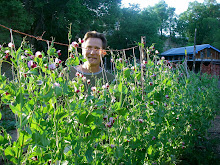After a long, snowy winter, spring finally began to overtake winter in the very last week of March here in Santa Fe. The Crocus and Iris reticulata were the earliest blossoms, along with hellebores and chionodoxa.
With the weather too chilly to start seeds outside, we turn to the greenhouse to jump start the garden. Here Dahlia has sown lettuce seeds thickly, and then transplants to one or two per pot when the first true leaves appear. This technique is useful when working with older seeds of uncertain viability. The little transplanting tool shown is perfect for moving delicate seedlings. The key to success in transplanting is to use a gentle hand!
Mrs. B purchased this light bench a few years ago and it is just wonderful! The lights can be easily raised and lowered. It's on a timer to optimize the light.
Just after sowing, I like to cover the trays with clear plastic wrap. This keeps the soil evenly moist, especially important with tiny, surface-sown seeds. Once the plants have sprouted it can be removed.
Watering tiny plants is another delicate operation. I try to just dribble water around the plant without actually hitting it. These seedlings are in 2" pots, which will be adequate up until it's time for them to go into the ground.

Even better than plastic wrap is a flat with a clear raised cover. These keep the plants in a higher humidity than we have, even inside the greenhouse. Many plants benefit from this environment, but they must be gradually hardened off to accept the harsh reality of outside life.
At LQ the greenhouse also serves to overwinter many of the tender potted plants which are placed around the garden after all danger of frost has passed.
Unfortunately, in spite of our most diligent efforts, by spring we invariably have insect pests in the greenhouse. The populations of aphids and white fly, as well as scale and mealy bugs, soar once the spring sunshine begins to warm the greenhouse. Air circulation, yellow sticky traps, and hand-picking are the controls we've used. This is usually enough to keep the seedlings safe from attack, but we have had trouble with a few particularly delicious crops.
The rock garden is one of the earliest places to color up in the spring. Rocks store and reflect heat, giving nearby plants a bit of an edge.
Helleborus species have received a lot of attention from plant breeders lately, resulting in glorious early blooms for our gardens. These tough survivors do surprisingly well here, as they tolerate alkaline soil, drought and cold.
What more could we ask for? The bees certainly appreciate it!
Brilliant yellow crocus brighten the garden in early spring, a promise of the wonders to come.
Chionodoxa carpet large areas beautifully, increasing by seed and bulbils annually.
The earliest daffodils are up, trumpeting revelie to the rest of the garden.
Another lovely crocus; I believe this one is called "Lady Killer". Works for me!
As I walk around to the north end of the property, I find that the snow still lies deep.
Yet even on the cold side of the garden, I discover delicate Iris reticulate varieties popping up in sunny spots.
The Iris is a wonderfully varied genus, and plant breeders have added countless variations to the different species. It's easy to find a spot for these tiny early marvels.
Here another delicious crocus positively glows with radiant beauty. All this is just the beginning of what is proving to be a most wonderful year in the gardens at LQ.




























No comments:
Post a Comment